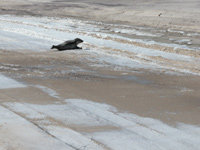 |
 | |
  | |
|
|
|
|
Fire Island National Seashore
Mammals
|
|
|
mammals includes: | Deer
|  | | | |
|
|
| |
 |
|
More than 30 species of mammals either visit or live within the boundaries of Fire Island National Seashore. These mammals range in size from finback whales and other whales— which occasionally swim close to shore or wash up on the beach—to the tiny masked shrew, which though rarely seen, is very common throughout the island.
|
 |
| Watch closely as you hike through the swale. You may catch a glimpse of a fleeing fox! |
 |
Seventeen species of terrestrial mammals were identified on Fire Island during surveys conducted in 1974.
In the mid-1970s, eastern cottontail rabbits (Sylvilagus floridanus) were abundant throughout the Seashore. Red foxes (Vulpes vulpes) were very common. Raccoons (Procyon lotor) were far less numerous. The white-footed deer mouse (Peromyscus leucopus) and meadow voles were abundant, and muskrats (Ondatra zibethicus) and Norway rats (Rattus norvegicus) were numerous on both Fire Island and on the mainland at the William Floyd Estate. Squirrels were restricted to the mainland.
Other common species identified in the survey included the masked shrew (Sorex cinereus), short-tailed shrew (Blarina brevicauda), and weasel (Mustela spp.). Weasels and mink were secretive but locally common predators throughout the seashore in the mid-1970s.
The little brown bat (Myotis lucifugus) was one of two bat species identified on Fire Island, while eight species were recorded at the William Floyd Estate.
It's interesting to note that in the mid-1970s a herd of only approximately 50 white-tailed deer (Odocoileus virginianus) was reported to be maintaining itself on Fire Island, where they have no natural predators and are protected from hunting. Within a quarter of a century, that number had swelled.
|
 |
| Seals occasionally rest on Fire Island's beach during the winter months. |
 |
Nineteen species of marine mammals—whales, porpoises and dolphins, and seals—have been recorded within the boundaries of Fire Island National Seashore. The harbor seal is a regular winter visitor at both Fire Island inlets.
Three species of endangered whales may occur in the waters offshore of Fire Island: (Balaenoptera physalus), (Megaptera novaeangliae) and (Eubalaena glacialis).
|
|
For More Information
Recent studies and inventories of mammals on Fire Island include:
for the Reformulation of the Shore Protection and Storm Damage Reduction Project South Shore of Long Island, New York - Fire Island Inlet to Montauk Point
January 2004
U. S. Army Corps of Engineers
|
|  |  |
|
|

Science in the National Parks
Learn more about the science-based programs in the Northeast Region of the National Park Service.
more... | | 
Threatened and Endangered Species
Fire Island Nationalal Seashore provides important habitat for several T & E species.
more... | | 
Fire Island's White-tailed Deer
Population has grown, but monitoring and research are conducted to learn more about the deer herd.
more... | |
|
|
|
|
|
|
|
 |
|
Did You Know?
The Floyd family left to the National Park Service more than 3,000 books from their family's personal library. A number of books were written by descendants of William Floyd, who lived in the house at "Old Mastic."
more...
|
|
|
|
Last Updated: March 14, 2007 at 12:45 EST |






